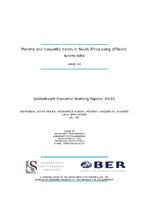| dc.description.abstract | There is an abundance of literature adopting the monetary approach (i.e., using per capita income or expenditure variables) to derive poverty and inequality trends for South Africa since the transition. The most commonly used data sets used for these analyses are the censuses and the Income Expenditure Surveys (IESs) conducted by Statistics South Africa (Stats SA). However, in some recent studies, alternative data sources were used, namely the All Media Products Survey (AMPS) by the South African Advertising Research Foundation (SAARF), as well as the National Dynamic Income Study (NIDS), which is conducted by Southern African Labour and Development Research Unit (SALDRU). Some of the data sets are problematic in a particular year or in more than one year, which in turn makes the comparison of poverty and inequality results across the years difficult. Examples of these problems are as follows: the serious decline of income and expenditure between the 1995 and 2000 IES; the high proportion of households with zero or unspecified income in the censuses; too few household expenditure bands in the General Household Surveys (GHSs). In addition, in the various studies mentioned above, different poverty lines were used in the poverty analysis, with the most commonly used poverty line values being R250 per month in 1996 Rand, US$1 a day, US$2 a day, as well as R211 per month and R322 per month in 2000 Rand (i.e., the two official poverty lines proposed by Woolard and Leibbrandt (2006). | en_US |

